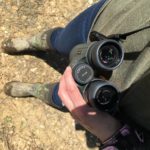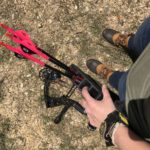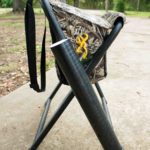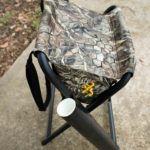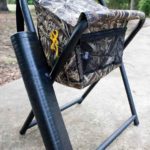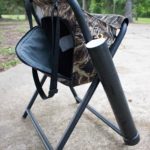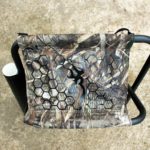How Many Trail Cameras Do I Need?
December 10th, 2017 by BTC Editor
How many trail cameras you need and why you need to leave them out year round.
By 2016 Outdoor Life Deer of the Year Award Winner Ryan Aulenbacher
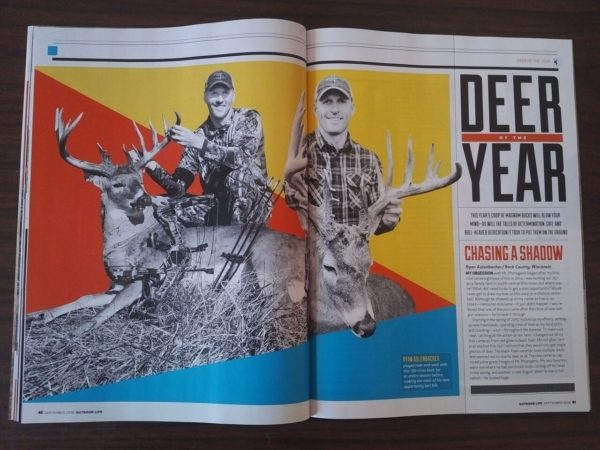
Putting cameras up during the season is great and then when you get one picture in mid-September you get excited. Only problem is you can’t tell if it was a one shot wonder or a resident buck. There lies your problem. Let’s say it was at 2AM. Was he going to bedding area or going to a feeding area or? In my younger years I would just pound that area with activity not really knowing if that was where he was most of the time. This not only didn’t result in getting said buck but I never even saw him with my own eyes.
The goal for me with game cameras is to try and start building that pattern early and get your stands in the woods before the season begins, or at least during early season. I don’t care how careful you are when it comes to scent control, it’s very hard to keep an area scent free during the season when you are banging around with a tree stand, breaking a sweat, and cutting branches for shooting lanes. From my years of chasing these one shot wonders I can tell you it’s not a successful strategy.
That’s why the cameras need to be up year round. I literally leave them up 365 days a year. With today’s cameras that may be 2 sets of batteries a year and with a Browning Trail Camera that’s only 6 AA batteries at a shot. That’s less than $5 a year in batteries. That’s pretty cheap scouting if you ask me. As a side benefit you also can get a better view on the predation, the number of fawns you have each spring, and an occasional Morel hunter who can’t read No Trespassing signs.
So what is a pattern? It’s when you are seeing deer come through at some similar time periods within close proximity of days. Knowing what direction he is going helps as well. When you start seeing him 2-3 times a week he likely is just out of camera view the other days. Try and use your best guess on where his bedding and feeding areas are with this information. If you are getting weekly pictures of him you surely are in “his home.” Hopefully you have an intercept point ready to go.
Once you start keeping your cameras up year-round, you may notice deer moving from their spring pattern to summer pattern and then to their fall pattern when they lose their velvet. This is also when you should be trying to hone in on a pattern. For example; are the bucks following the river or are they headed into the corn at a certain spot? Do I have any coyotes on this side of the property? (Disclaimer: being on the non-coyote side of the farm is like being in the non-chlorinated side of the pool; there is no such thing but I find that like deer, coyotes are more active in certain areas.) I notice that if I start seeing coyotes in one area with my cameras I don’t see many does and fawns in that same area. On the flip side, I have noticed that bachelor groups in early summer won’t show much of a change due to predator activity.
You need to move your cameras throughout the season as well to help pattern your bucks. Don’t go throwing them up in the middle of a bedding area, but you do need to change where you place them throughout the year to see if the deer are entering and exiting an area in the same or a different spot from the month or year prior. You need to have fresh data to go off of.
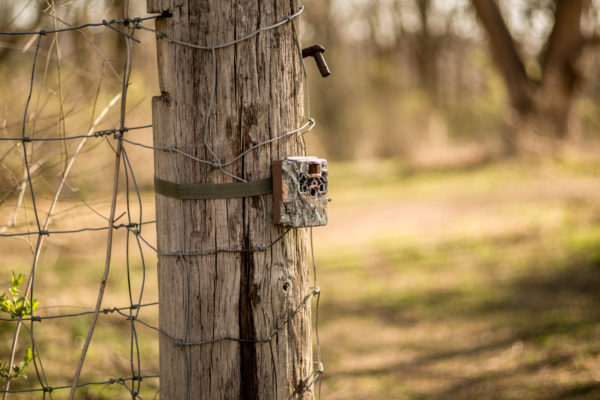
For instance, my buck that was on the cover of Outdoor Life I had on camera in the same area on 2 different cameras every 3-4 days from August until November. The cameras were about 100 yards apart in an area just outside of what I believe was his bedding area. I set up my stand at an intersecting point trying to get him on the way back in during AM hunts and on the way out during PM hunts.

A few years prior to my deer that was on the cover of Outdoor Life I had shot another good buck. The following year I left my cameras and stands in the same areas and basically hunted the pattern of a deer I already killed the year prior. It hit me as I sat there late in the season not seeing any mature bucks. “Why am I in this stand? What deer am I hoping to see? I didn’t have any patterns developed…” That’s why you need to try different spots every year with your cameras. Yes, you have good “areas” year after year on your land but with bow hunting you need to know the right tree not the right area.
So how many cameras do you need? Well that’s tough to answer in a vacuum. I think the better question is, where do I need them? I would definitely try and get a camera up where they have the most activity coming in and out of your land near some edges or bottlenecks so you don’t disturb bedded deer. Until you have a pattern developed I would be vigilant with scent control and check them at least once per week or maybe more during hunting season. I could easily see you having 2-4 cameras out on 40 acres.
Let’s say you have 250 acres. This is where you can really start to pattern a deer because it may spend the majority of its time on your land. Going off my experience in rural farming areas of WI where we don’t have massive 400-acre wood lots, more of 80 acres of field and 20 acres of woods and then 20 acres of Marsh etc., I would try to get a camera in each area. So each separate woodlot or cover area would get a camera. On 400 acres of farm country that might be 10-20 cameras. I hunt property that is about 200 acres and I have 8 cameras out now (6 black flash/ 2 RED IR). So that will be around 1 per 25 acres. In doing some research, that is a number you’ll see come up by other hunters and writers as well.
Once you figure out a spot to sit, remember you are in “his” area now and he will notice anything out of place, so don’t put a stand up without taking extreme scent control measures. I typically wait until right before a rain event to move a stand during hunting season. I like having the rain wash away any scent I may leave. You would hate to take all the time to develop a pattern only to change it!
Get your trail cameras out there and keep them up the whole year. We have so much more technology available today to help us become better hunters if we figure out how to use it correctly. Good luck!
4 Seasonal Trail Camera Techniques
November 5th, 2017 by BTC Editor
Trail Cameras have become a big part of the modern hunters scouting strategies. But many fall short by not putting in the time to scout and find new places to put their trail cameras. These 4 simple trail camera techniques will help you get more pictures of your monster bucks.
EARLY SEASON
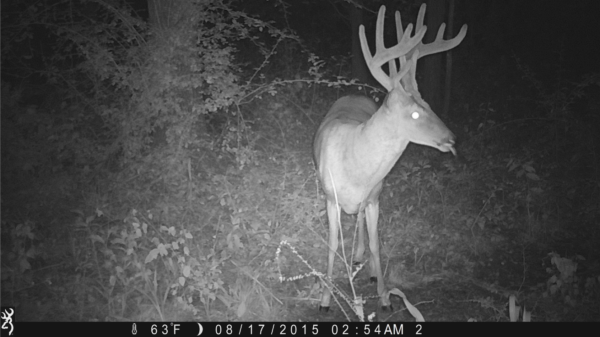
As the bucks begin to grow and racks begin to form, it is time to put trail cameras up on popular mineral sites. The nutrients deer need can be found in these minerals for the growth of antlers and milk production of fawns. This is a great place to determine deer density and take an early season inventory of your deer herd.
PRE-RUT

This time of year, bucks shed their velvet and their testosterone levels begin to rise. When scrapes and rubs become more visible, it is time to move your trail cameras. Scrapes are a great place to find mature bucks looking for receptive does. Most bucks visit scrapes in the cover of darkness, but are easy to get great pictures of.
RUT

When the does start to come into heat, bucks really start to move. As bucks begin to seek does, food sources become a hot spot for deer activity. By putting a trail camera on the edge of a field, you are likely to get pictures of bucks checking for receptive does. Also helping to show where and what time they enter the field.
POST-RUT

As the rut winds down, bucks begin showing the toll of heavy rut activity. Low body weights and broken, beat up bodies, bucks become slaves to their stomachs. This is the time of year that corn stations or late season food plots become key trail camera spot. These pictures can help you find out what bucks made it through the season and ones to write off the hit list.
Blog originally posted on The Break TV blog by team member Stephen Jones.
The “30/30” Trail Camera Setting
October 22nd, 2017 by BTC Editor
Just a couple weeks ago I made my first series of mock scrapes for the year and placed my Browning Trail Cameras on all of them using what I call the “30/30 setting”: Video mode set on 30 second clips with 30 sec delay. It didn’t take long before the first mature buck found one in less than 24 hours of being made, and within a couple days they all started to heat up. I noticed one series of the three was showing more activity from a specific deer than the others. I knew right away this was a deer I wanted to target, but how was I going to be able to do so? The October lull was here and everything was happening at night. I knew if I wanted to harvest this deer I would have to do so fast, before love pulled him away.

I chose to focus on checking that series of three cameras the most frequently, using wind and time of day to my advantage. By having them on the “30/30 setting”, I was able to see direction of travel and study the specific behavior of the deer I was targeting. Once I was able to get a general direction of travel, I used what I refer to as the “leapfrog method”: moving 2-3 cameras in the direction of travel, leapfrogging them as I checked them. This helps me stay on where I had him last while exploring my thoughts with the newly moved camera. I gained a very solid direction of what I thought was his daily routine – deer of a mature age class are very much creatures of habit – but even having a solid route of travel, I feared I was getting too close to his bedroom. I elected to not move in any further and let my Browning cameras continue to do my homework for me.

Over the course of a couple weeks I checked the cameras in a three-day rotation, as long as the wind stayed true to checking them. The pattern was there but since he was still moving after dark I was going to have to get aggressive, yet smart, if I was to win this chess match. I checked the weather on a site I live by called Weather Underground. This site lays it all out in a graph for me. I noticed an upcoming front with precipitation was a few days out. It was calling for rain for almost an entire day, ending the next day mid-morning with a temperature drop, wind drop, and rising barometric pressure. I knew this had to be the time to make my move!

A couple of days went by and the rain set in. I was going to move in and hang a stand under the cover of good wind. The noise from the rain would cover me, and the wet forest floor would make for sneaking in an easy task. I was able to get my stand hung while staying undetected and pulled all the SD cards on my way out. My thoughts were staying true. My trail cameras showed he moved daily until the front hit and didn’t move that night or morning at all. I knew that after the rain he would likely move, as barometric pressure would be rising with a sudden drop in wind. I was going to hunt the following afternoon.
The following day rolled around and the weather stayed true, my information from my cameras were spot on, and I was able to harvest a beautiful mature 8 point.
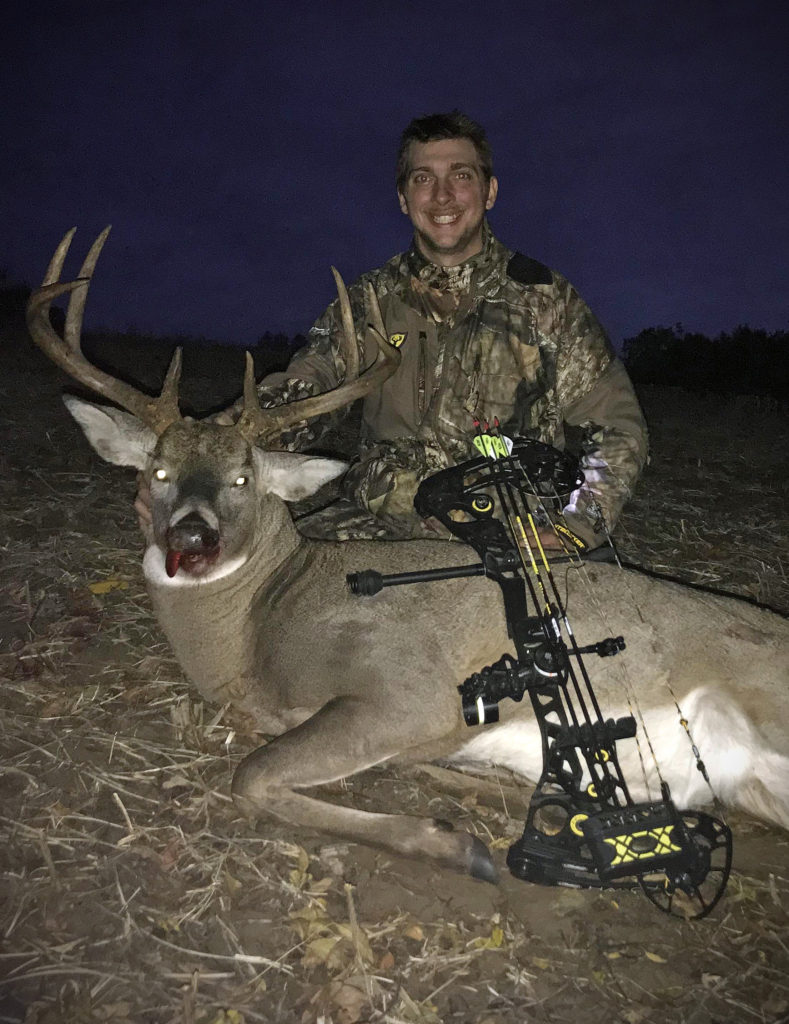
When targeting scrapes, deer will likely want to freshen them up after precipitation. If you accompany that with a drop in temperature, high barometric pressure and a wind drop, it can often be the ticket to bucks getting on their feet a little sooner. I relied heavily on my Browning Trail Cameras to help me pattern this particular buck. Without being able to further pin down direction of travel I don’t think I would have been able to catch him during legal shooting hours, let alone a full hour before dark.
By John Steinhauer
Shifting Deer, Shifting Cameras
September 24th, 2017 by BTC Editor
We’re beginning to get some early fall temps and the taste of clean, cool air. The skies are beginning to look a little different and we are both beginning to feel a bit different. We are anticipating…
Having found a new core bedding area via trail camera recon (photos below) we are now closing in on exactly how this section of property functions and we are stoked for the postseason and the chance to move cameras into this area and establish precise buck bedding locations. However, we still have the ENTIRE NY deer season in front of us and we now know that we have a prime buck bedding location nailed down adjacent to an area the local does bed in. As we continue to work on peeling the layers off that scenario we will ramp up our mock scrape game using our cameras to tell the story of these locations. This year we are adding into our equation several rubbing posts with overhead licking branches where we will begin to test the waters of the local big boys and hopefully provide ourselves another late October/early November tool for our arsenal. As all these fellas begin to take on their fall ranges and each personality begins to show we become probably a little too eager as we wait for the right time to make our next card pull, but hey, this stuff is what it’s all about.
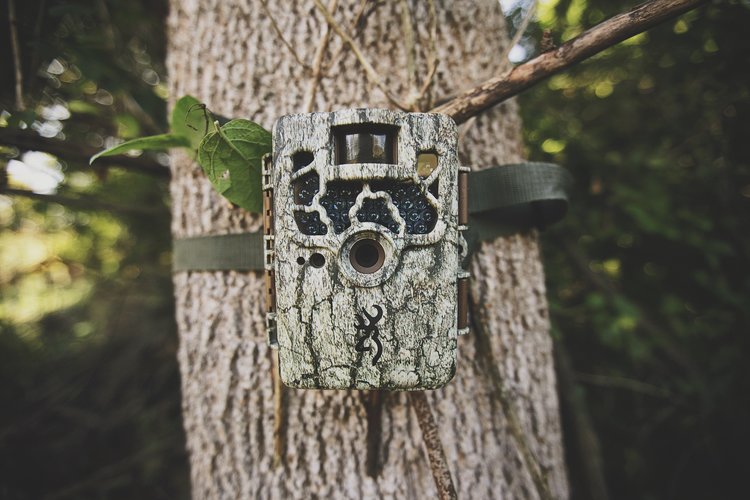
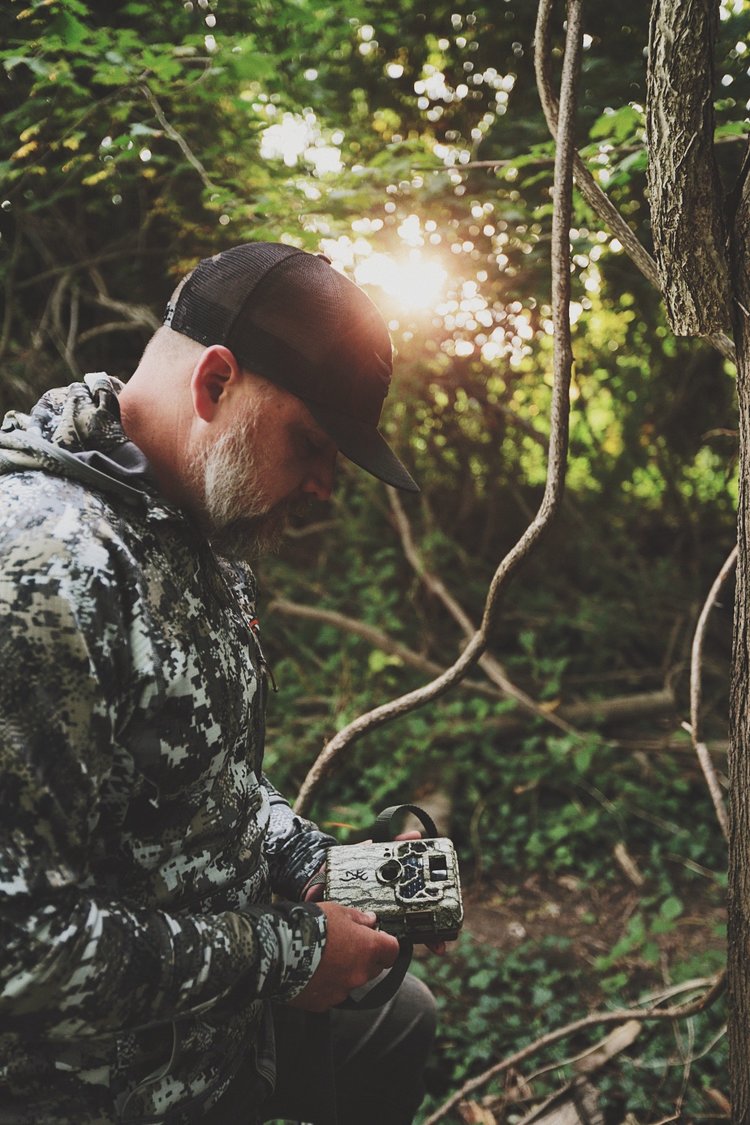
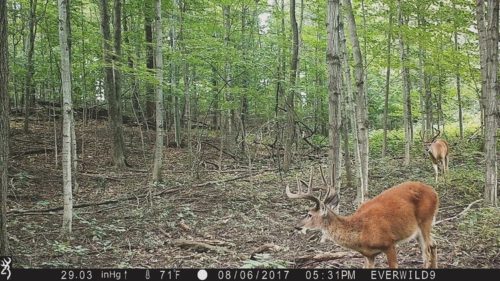


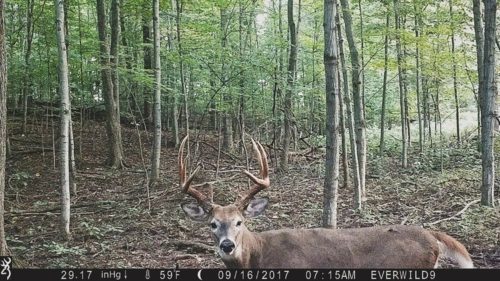

Blog originally posted on EverWild.
EverWild is an online journal of the outdoor adventure’s of two friends from New York – Justin Michau and DJ Tosh – who are passionate about the outdoors.
Choosing Your First Trail Camera
July 16th, 2017 by BTC Editor
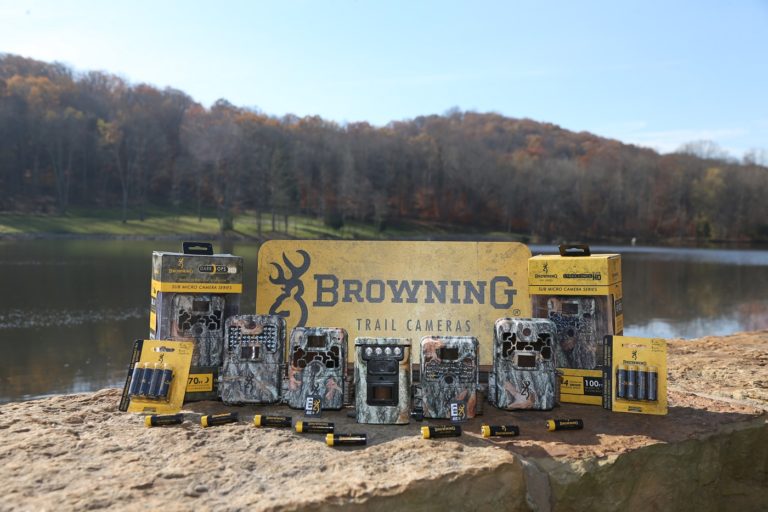
Trail camera technology has really improved over the years and there are more features than ever, allowing you to customize your trail camera experience to your liking. For someone who is new to hunting or the trail camera world, picking out your first game camera can be somewhat overwhelming, especially if you don’t know what features you need or what the features even do. After someone recently asked me for advice on what they need to look for when purchasing their first camera, I decided to share a few things that I feel are “must-haves”, as well as some bonus features and accessories that may be an asset to you.
Features
I really feel a lot of features on trail cameras are user specific and depend on user preference. I’ll briefly explain the features that I feel are the most important when considering which camera to buy.
Flash Type
The flash types are: White flash, Black flash (Invisible, or No-Glow), and Standard IR (InfraRed / Low-Glow). Tom Rainey of Browning Trail Cameras wrote a really great article for this blog explaining each flash type and their effect on trail camera picture quality: http://btc-omrc.com/nighttime-trail-camera-images-putting-light-on-the-subject/
Basically, the highest quality nighttime photos will be from White Flash cameras, then IR cameras, and then Black Flash cameras, but that’s not to say that the quality of the nighttime images from Black Flash cameras are bad. You just may notice a little more motion blur on them.
So, a few things to consider when choosing the flash type:
Where will you be putting your cameras?
If you are going to be putting them on public land or in an area that is known to have a lot of trespassers, you will probably want to go with a Black Flash camera. Otherwise, one of the previous two flash options may be what you would prefer.
Do you feel a White Flash or Standard IR camera will spook the game you are hoping to get pictures of?
If so, a camera with Black Flash may be best for you. My personal experience with Standard IR and White Flash cameras is I feel the animals get used to them. I haven’t noticed them spooking deer in the years that I have been running trail cameras. Everyone has their own opinion on this and each location may be different, so again, go with your own personal preference here.
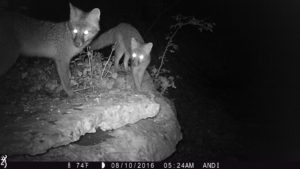
Detection Range
The location where you plan on putting your game cameras will help you decide which camera may be best for you in regards to detection range. If you are running trail cameras primarily in the woods or have it set up over pinch points and travel corridors, the detection range can be quite a bit lower. But, if you are watching over larger areas, such as fields, the detection range needs to be a little higher, especially if you aren’t quite sure where the wildlife are traveling.
For example, the Browning Command Ops has a detection range of 55 feet with a 60-foot flash range, which is great. But the Browning Recon Force Extreme has a detection range of 80 feet with a 120-foot flash range, which is quite a bit more. So, you can see how the higher detection range could be quite a bit more beneficial in certain situations.
Trail Camera Accessories
Obviously, SD Cards and batteries are must-have accessories for your trail cameras. But there are a couple other accessories that you may want to look into purchasing for your first trail camera, depending on the location the camera will be in and how often you plan on checking it.
Security Box
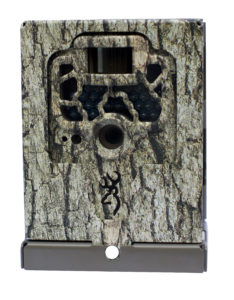 As I mentioned above, the location really is a key factor to consider when purchasing your trail camera. The same goes for deciding whether or not you need a trail camera Security Box. A couple things to keep in mind here: Do you expect there to be trespassers, or will the camera be on public land? Also, what types of animals are in your area? Do you have a high bear population? If you answered “Yes” to any of those questions, I recommend getting a Security Box. Browning makes one that fits all of their camera models (excluding the Defender 850). It can also be locked using a standard padlock or a Master Lock Python Cable so your camera stays safe and stays put.
As I mentioned above, the location really is a key factor to consider when purchasing your trail camera. The same goes for deciding whether or not you need a trail camera Security Box. A couple things to keep in mind here: Do you expect there to be trespassers, or will the camera be on public land? Also, what types of animals are in your area? Do you have a high bear population? If you answered “Yes” to any of those questions, I recommend getting a Security Box. Browning makes one that fits all of their camera models (excluding the Defender 850). It can also be locked using a standard padlock or a Master Lock Python Cable so your camera stays safe and stays put.
Trail Camera Power Pack
The Trail Camera Power Pack will extend the battery life of your Browning Trail Camera in the field. This is a great option if you don’t plan on checking your trail cameras very often. It holds holds 8 AA batteries in the same easy to use battery tray used in the trail cameras. Other features include a built-in battery tester and a twist lock plug to lock the power adapter to your Browning Trail Camera.

Bonus Trail Camera Features
Here are a few “bonus” features that you may also want to take into consideration when choosing your first trail camera. I personally don’t feel that these are features that you absolutely have to have, but I do feel they will enhance your trail camera experience. Personal preference comes into play here as well. Here are a few of my favorite features on the Browning Trail Cameras:
Viewing Screen
This is an internal viewing screen on some of the Browning Trail Camera models. It’s great for viewing trail camera photos in the field, and it really comes in handy when positioning the camera while you are setting it up.
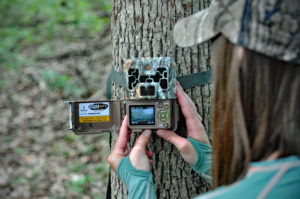
Timelapse Mode
The Timelapse function allows you to set up your camera in the field, and program it to take pictures automatically at fixed intervals. This feature is helpful when you set a camera up in a new location such as a large field or food plot where you are not sure where the wildlife are entering the field. The camera will take images of the entire field, so you will end up capturing game at 200 + yards away, where a conventional game camera would not normally trigger a picture. All Browning Trail Camera models come with this feature, as well as the Timelapse Viewer Plus Software, so you can playback a whole day’s worth of activity in just a few minutes, much like watching a video.
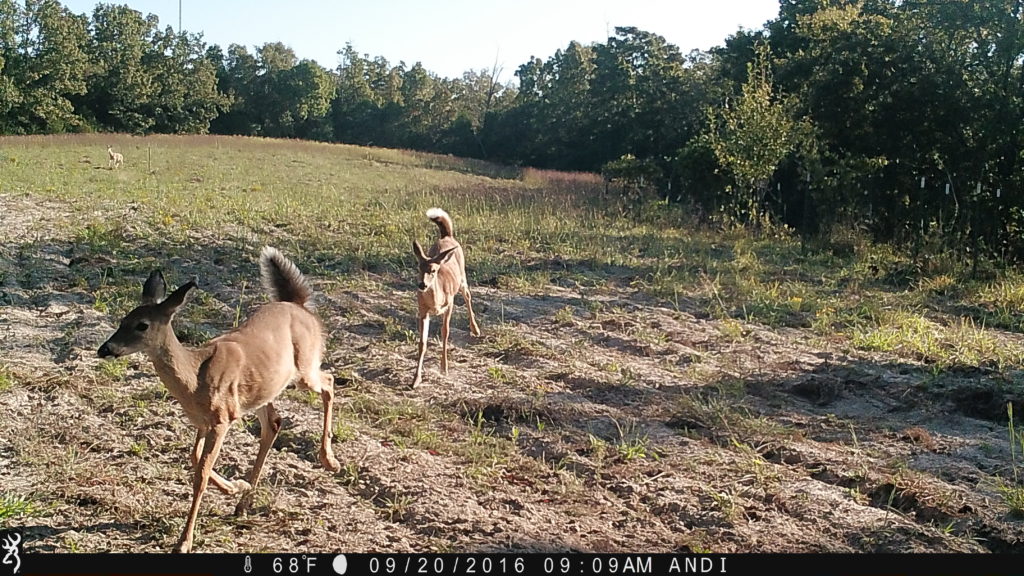
Multi Shot / Rapid Fire Mode
In certain situations, the 8-Shot Rapidfire mode is one of my favorites to use on my Browning Trail Cameras. It takes 8 shots in 2 seconds! I prefer to use this when I have a specific animal that I am targeting that I know will not be in the frame for long. For example, I wanted a Bobcat on this log setup, but I knew it would likely not use this log repeatedly and not stay on it for long, so I put it on Rapid-Fire mode to get as many photos of it as possible and pick my favorites to share. Rapidfire Mode is also great in deer season when you are watching a smaller area, such as pinchpoints and travel corridors, so you don’t miss any deer activity.

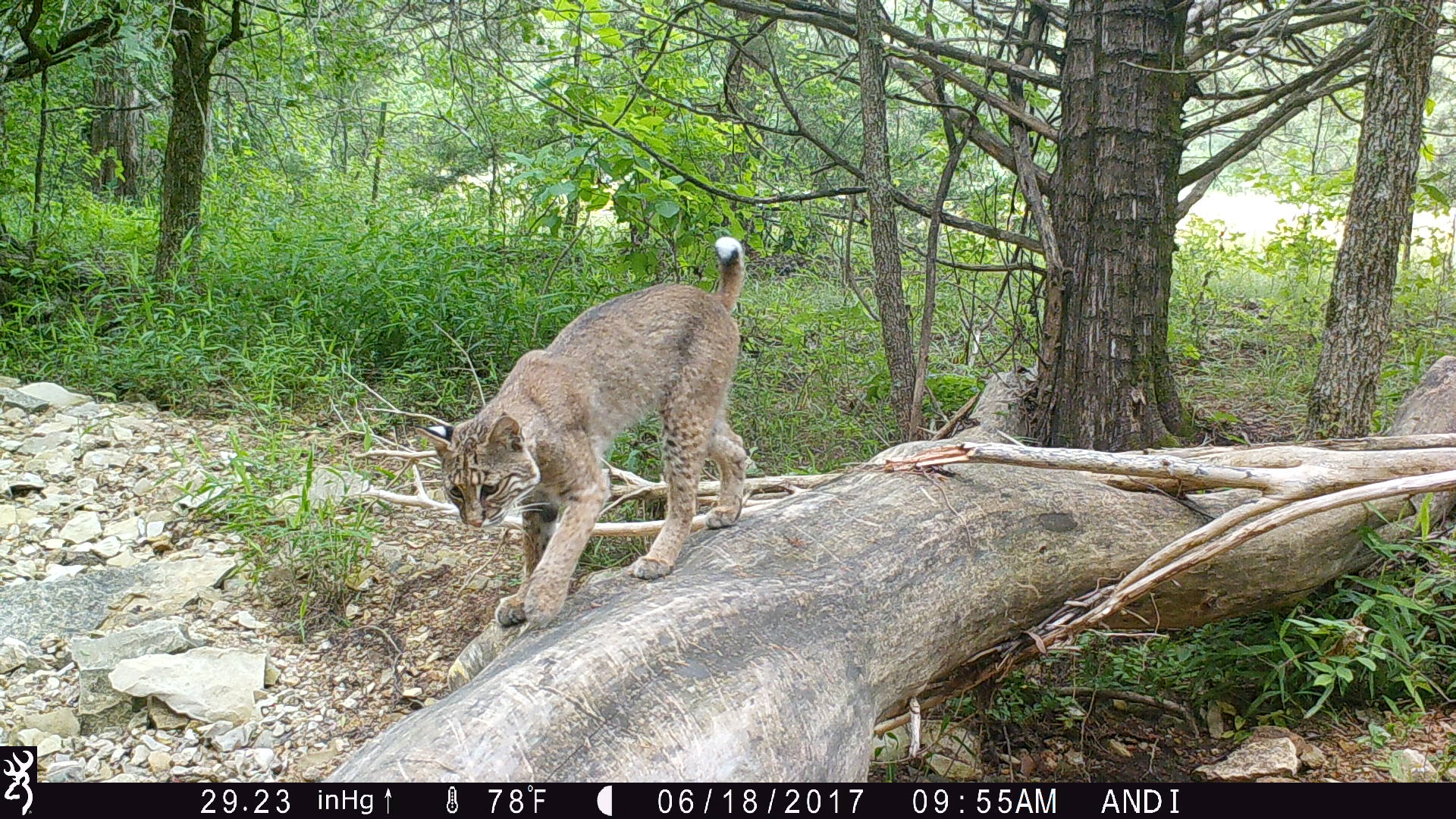

Video Mode
This is a really fun trail camera feature. It’s almost like watching the wildlife in person when playing the trail camera videos back! With 1920 X 1080P Full HD, the audio and the clarity in the Browning Trail Camera videos is really amazing. Additional new features for the 2017 model includes Smart IR video, which continues to record video footage while game is moving in front of the camera and SD card management options which allow you to overwrite older images on the SD card if the memory is full.
I hope this article helped you know where to start in shopping for your first trail camera! If you have any other questions that were not listed in this article please feel free to leave a comment below.
By Andrea Haas
Andrea Haas is a Pro-Staffer from Missouri who enjoys hunting deer, turkeys, and upland birds. She is also the founder of the Huntress View, an organization formed to help strengthen the ever growing community of women hunters
Homemade Venison Jerky Recipe
July 2nd, 2017 by BTC Editor
Making homemade jerky is a simple way to preserve excess meat, and when done correctly, can be stored 1-2 months. Depending on the ingredients used, it can serve as a healthy, high-protein and low-carb snack—perfect for training for upcoming hunts or while in the mountains hiking or hunting.
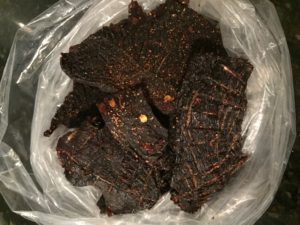
Below is the recipe I use. Ingredients are approximations, and can be adjusted based on individual preferences.
Ingredients:
- 3 lbs. venison meat (can also use elk or other meat)
- 2 cups teriyaki
- ¼ cup soy sauce
- ¼ cup brown sugar (dark or light is ok)
- 1 heaping tablespoon minced garlic
- 1 tablespoon Cajun seasoning
- 1 tablespoon dried and crushed hot peppers (such as cayenne, jalapeno or habanero)
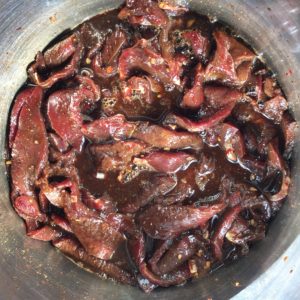
Instructions:
- Slice meat into 1/8”-1/4” slices using meat slicer
- Combine all ingredients (except meat) in small pot, mix well and heat over a low heat just enough to dissolve the sugar
- Add meat to liquid mix, one piece at a time, ensuring all pieces are thoroughly coated
- Place meat and all liquid in Ziploc bag and refrigerate at least 4 hours (I prefer overnight for a stronger flavor)
- Place slices of meat on dehydrator racks, making sure not to overlap any of the pieces
- Let dehydrate for 7-8 hours at 155°F
- Remove from dehydrator and store in plastic Ziploc bag

Additional information:
- 3 lbs. of raw meat yields approximately 1 lb. dried jerky
- Many people use a jerky gun, but I prefer making jerky with sliced meat instead of ground meat. I have a restaurant-quality meat slicer, but good slicers can be purchased at Bass Pro or Cabela’s.
- Sugar can be omitted for a lower-carb recipe; can also substitute a can of crushed pineapple
- Cajun seasoning and hot peppers can be omitted if you prefer non-spicy jerky
- I recommend the Nesco American Harvest Dehydrator, available for purchase on Amazon. I purchased this in 2009 and have used it for multiple batches of jerky every year, as well as for drying fruits and veggies in the summer. It comes with four dehydrator racks, and more can be purchased separately.
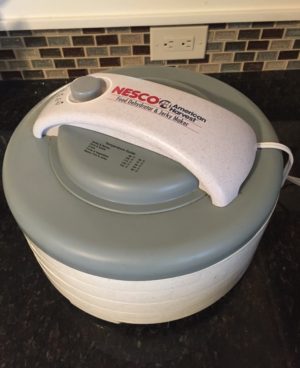
This is our go-to recipe, but would love to hear your jerky recipes. Please comment with your favorite recipe, or any tips you have for making jerky.
Sarah Honadel is an avid outdoorswoman from Kentucky, now living in Idaho, who enjoys hunting turkey, deer and elk. She is a Team Member at Huntress View and Brand Champion for ReelCamo Girl, two organizations that work to support, encourage and empower women in the outdoors. Follow her on Instagram @waddysarah and @arrowridgecreations.
Intro to 3D Archery
June 4th, 2017 by BTC Editor
Off season blues? No problem! 3D Archery is a great way to keep you occupied while waiting for your next hunting season. If you’ve never shot a 3D archery range then keep reading, this post is for beginners and what they will need to know before starting 3D archery.
I started competing in 3D tournaments this year to challenge myself, to continue shooting my bow during the off season, and to keep myself active outside. Not only do these tournaments help with my consistency but they have also helped improve my ability to judge yardage. Depending on your location, you could probably look online to find a local archery organization. If you can’t seem to find one online usually your bow shop can help you out by referring you to a few.
Once you find an archery association/organization you can then ask them for a copy of their tournament schedule if it’s not listed online. You will also need to know that specific organization’s available shooting classes, rules for shooting and what scoring system they will use.
I want to mention all the necessities you may need to start shooting competitively.
Essentials:
- Bow (obviously)
- Release aid
- Quiver or archery stool that can hold arrows, keys and accessories
- Binoculars (I love my Vortex Viper HD’s in 8x42mm –Has plenty of magnification and lets in tons of light in order to see targets efficiently)
- A bow kick stand that stands bow upright so you don’t have to lay it down on the ground
- At least 5 arrows, possibly more if you believe you will miss targets or damage a few on other shooters’ arrows
- Pencil (if one’s not provided)
- Rubber boots as a backup in case your range is muddy
- Tick/Mosquito spray (We like to spray Scentblocker’s Tick spray on our shoes the day before and it usually last a few weeks)
- Sports drink to keep you hydrated (I prefer Mtn Ops Yeti or Enduro)
- Snacks are usually available at a small cost but it’s probably a good idea to bring either a granola bar or PB cracker type snack
- Water (This is usually provided for free throughout our range but sometimes they’re all gone by the time we go through the course)
Before you shoot in a tournament it may not be a bad idea to find someone that actually shoots them first and just do a walk through with them while they shoot. I did this to make myself more comfortable in knowing how things ran and how the targets are scored. I was less intimidated when I actually shot in my first since I knew how everything worked. If you can’t find someone to walk through with, no biggie, shooters at 3D tournaments are usually very nice and encouraging. I can honestly say I have not ran into a single person that wasn’t willing to help a beginner. It was very calming to be able to get advice from people that not only shot in them regularly but seemed to not be bothered at all by a newbie trying to figure out how the tournaments worked. Again, this is part of the reason I have fallen in love with archery. The archery community is so supportive and educational.
Most 3D tournaments have a variety of classes to shoot in based on your level of skill and your bow setup. For example, the tournaments I have been shooting in have:
- PeeWee
- Cubs
- Longbow
- Traditional
- Youth
- Women’s Youth
- Women’s Bowhunter
- Women’s Open
- Novice
- Bowhunter
- Bowhunter Outlaw
- Senior Open
- Open Class
- KNOWN 45
- Pro Class
Each class will have general rules for being able to shoot in it and will also have different colored stakes to shoot from at the archery range.
Some rules to keep in mind: (Rules may vary slightly depending on the archery club)
- Each club will have a max arrow speed and also have the right to chronograph any shooter at any time
- Rangefinders are prohibited unless shooting in the KNOWN class. All other classes require distances to be judged by the naked eye.
- Binoculars/spotting scopes may be used determining shot placement
- Bowhunter class is restricted to a 12” or less stabilizer, screw in or glued in tips, and may shoot a movable sight (but it must be a HUNTING sight with NO magnification)
- Bowhunter Outlaw class is restricted to bowhunter equipment ONLY with hunting sights and NO magnifications. This is the only class with no max speed limits
- Exchanging yardage information is strictly prohibited
- Each shooter must be touching the appropriate shooting stake for their class with some part of their body
- A “controlled letdown” must be verbally announced
- Once your sights are set and bow has been drawn you cannot reset your sights after a controlled letdown
Here are a few tips I would recommend doing before tournament day:
- Make sure your sight pins are sighted in to ranges that vary for your shooting class
- For example, I shoot in Women’s Bowhunter and the ranges will vary but usually the farthest distance is 25-30 yards at our specific archery club
- There are also moveable hunting sights that are great for 3D tournaments so you can easily adjust the distance per target.
- I practiced at home shooting the distances my pins were set at and really looking at the animal to help myself with judgement of distances. Sometimes I would walk at a random distance, look at the target and guess in my head and then use my rangefinder to see how close I am to guessing correctly. I continue to do this until I am comfortable with my guesses
- Make sure gear is all together and ready to go
- Make sure to get plenty of sleep the night before
- Make sure to eat a healthy breakfast before
Upon arrival:
- I usually sign in/register and get my score card
- I then head to the practice bags and shoot at each one that I have a pin set up for to make sure they’re all sighted in. I double check my arrows, release and bow to make sure everything is in good shape
- We usually shoot in a group with friends and “draw cards” for our shooting order. We will mix them up (faced down) and get one person to draw one card at a time and we will use that as our shooting order. This helps keep it fair because some targets are harder to see where to aim and being the first one to shoot those types of targets can be a little tough. Some shooters will have bright colored fletchings so that makes it easier for the next person to use as a guide on aiming.
- Side note: Our group sizes vary from 3-5 but I personally believe a group size of 3 is the best. Groups of 5 tend to take longer shooting each target and going through the whole course in general
When shooting at a target I usually go through a series of steps to help myself make a good shot. I like to going by these steps in order to be consistent. These steps may be a little different for each person but once you start doing things in a way that works keep doing them the same way EVERY TIME. I promise they make a difference.
When shooting at a target:
- I find the appropriate shooting stake and place a foot on one of the sides of it. It doesn’t matter where as long as some form of your body is touching it.
- I usually go ahead and nock an arrow and prepare my arrow rest.
- I then look at the target through my binoculars and try to find where I need to aim. The best way to do this for me is to look for specific things like: the shape of the target, which way it’s facing, if it’s leaning backward or forward, if there are any distinctive parts on it such as areas that are shot up or if it has spots you can use to help as a guiding tool. Aim small, miss small is a very accurate statement in this case.

- I then look at the target through my binoculars and try to find where I need to aim. The best way to do this for me is to look for specific things like: the shape of the target, which way it’s facing, if it’s leaning backward or forward, if there are any distinctive parts on it such as areas that are shot up or if it has spots you can use to help as a guiding tool. Aim small, miss small is a very accurate statement in this case.
- I make sure my feet are shoulder width apart and as flat as possible.
- Draw bow.
- Find aiming location in peep and match it with appropriate pin.
- I make sure my peep sight meets up perfectly with my sight housing. If I’m shooting uphill/downhill and will have to lean some way I make sure to lean with my waist and not just with the bow as this would affect how my peep sight and sight housing meet up.
- Relax bow hand and rest pointer finger on my trigger.
- Continue to breath, relax muscles and release.
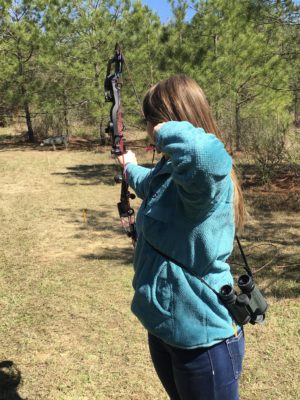
When scoring targets, it’s important to know which scoring system the archery club/organization is using. There are two primary organizations that have their own scoring systems: Archery Shooters Association (ASA) and International Bowhunting Organization (IBO). The tournaments we shoot in only use ASA scoring system and the “Upper 12” can only be called or used if the targets specifically shows it can. Here are a few pictures that show the difference in the two.
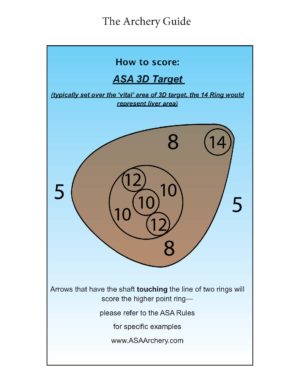
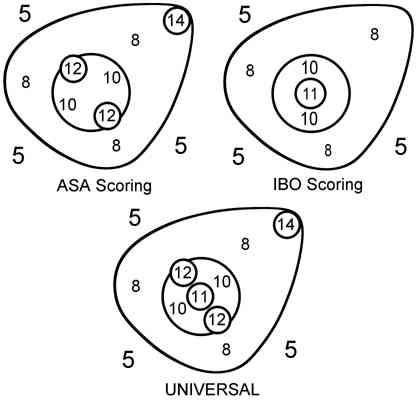
If you’re a beginner or not shooting in a Pro class, it’s important to remember these tournaments are for fun and to help you improve. Bad shots will definitely come and you’ll more than likely miss a few targets. Don’t stress too much about those because they have happened to everyone at some point and they help you learn from your mistakes. So good luck to all you beginners and remember to have fun!
Note: If you plan to consistently shoot year after year I suggest investing in an “archery stool” of some sort. I currently use the Browning Steady Ready Stool with PVC pipe attached to the leg. We taped the pipe with black electrical tape and glued a cap on the bottom so that it can be used as an arrow holder. The stool has a mesh zipper pocket on one side and an insulated cooler pocket on the other. You can put ice and drinks in the cooler but we didn’t want to make the stool too heavy to carry so it’s used to hold our extra accessories (keys, binoculars case, back up release, snacks, etc.).
Courtney is an avid hunter from Louisiana. She has a passion all things outdoors and is an avid hunter. She is also a team member of Huntress View, an organization formed to help strengthen the ever growing community of women hunters.
5 Summertime Trail Camera Tips
May 21st, 2017 by BTC Editor
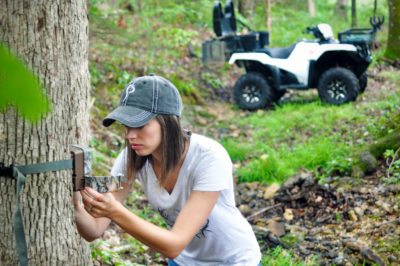
1- Summertime is when most hunters get their trail cameras out of storage and hang them to start taking inventory of their whitetail herd. It’s also a great time to take inventory of your trail cameras. Make note of how many you have, how many more you may need for the upcoming season, and also keep a list of each camera model and serial number in the rare case of theft. It can, and does, happen so keeping a record of this could help get your cameras back eventually if they do get stolen. Browning Trail Cameras also has a Security Box that makes it more difficult for thieves to take your cameras, if even at all.
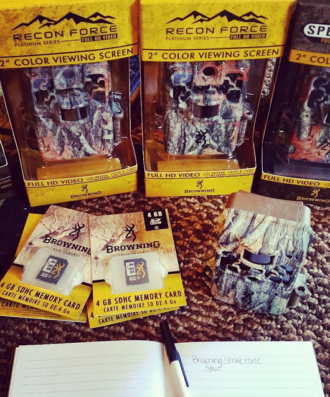
2- Look at an aerial map of your hunting property beforehand so you have a good idea of where you’d like to hang your cameras. This way, you’re not driving or walking all over your property, disturbing the game and working up a sweat. If you have a weather app on your phone you can easily locate your property via the radar portion of the app. If you don’t have that, Google Earth is what I recommend. It’s probably a good idea to take a screenshot of your property and from there mark where you are placing cameras using the paint/draw tool on your phone in case you forget where you hung the cameras later on.
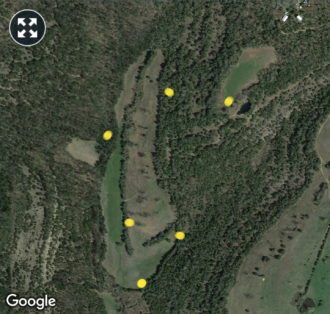
3- Summertime is obviously hot, even first thing in the morning, so in order to be out in the heat as little as possible it’s best to have everything ready to go before you head out. Have your trail cameras already set up with the correct date/time/camera settings, full with batteries and the SD card in so all you have to do is hang them, turn them on, and go!
A Browning Trail Camera feature that really helps get your camera positioned quicker is the viewing screen on some of the camera models. (See photo below.)
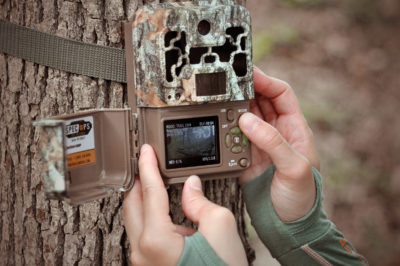
4- Everyone has their own system for transferring and storing trail camera pictures to their computer. I like to stay organized from the start by putting my SD cards in 2 separate cases – one for blank SD cards, and one for full SD cards – and then loading the pictures to my computer once I’m home. A baggie works just as good, just make sure you label each one to avoid confusion. Some prefer to bring a laptop and transfer the pictures there in the field, but I like to get in and out as quickly as possible and this works best for me.

5- Last but not least, don’t forget the tick spray! So far this year has been one of the worst I’ve seen for ticks. Using a tick spray with Permethrin has worked well for me. Spray down your clothes and boots and make sure they’re dry before putting them on. You do not want this on your skin! For those worried about scent control, this kind is supposedly odorless once it dries. My nose is of course nowhere near as good as a whitetail’s, but I don’t smell it at all once it’s dry and would prefer to be tick free over scent free anyways, so to me it’s worth it. It also doesn’t hurt to spray it on some of your trail cameras to avoid ant infestations, which are very common in the summer months.
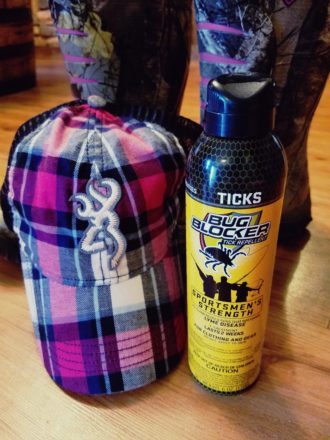
By Andrea Haas
Andrea Haas is a Pro-Staffer from Missouri who enjoys hunting deer, turkeys, and upland birds. She is also the founder of the Huntress View, an organization formed to help strengthen the ever growing community of women hunters
The First Hunt
April 9th, 2017 by BTC Editor
With having accumulated many special memories over the course of my 35 years of hunting, I can vividly remember so many details. Memories begin with my first successful whitetail deer hunt, my first turkey, and my first harvest with a bow. All of these events pale in comparison to being able to watch my eight-year-old son squeeze the trigger on his very first deer…a spike buck.
Like many fathers who love to hunt, my hopes had always been to raise my two children to share my passion for hunting and the beauty of the outdoors. I know many hunters; however, whose children had grown up with little or no interest in following in their father’s footsteps when it came to pursuing wild game. I often wondered what it is that separates those kids who develop the passion and those that do not. There is no sure way of getting or keeping our children involved in hunting, yet there are certain things that we can do to increase the odds of them developing that lifelong passion.
From my experience and from what I have learned from others, it is key to get them involved at an early age. Children generally do take an early interest in their parent’s passion for the outdoors. My children were always there when I would bring home a harvested animal. They would come rushing outside to take a look. Whether it was gutting a deer or processing one, I allowed them to be a part of it. I made sure to answer any of the questions that they may have had. I would always say to them, “One day you both will get to go hunting with dad.”
Once a child reaches the age where you feel it is the right time to take them hunting, you must make necessary changes to how you hunt. You are going to have to keep it somewhat “fun” in their eyes. It could be a tag-along trip where they sit with you or simply head out to do some scouting. Explain what you are doing and what you are looking for. Allow them to utilize some of the gear, such as binoculars or rangefinders. If you are like me, you may need to shorten the time frame of your hunt. For instance, you may be accustomed to a 4 or 5-hour sit, but now you may need to make it only a few hours to prevent the child from becoming bored. Once you detect boredom, either change things up a bit or head to the house.
You may ask yourself, “When is the right time to take your child hunting?” The answer depends on the individual child. I believe it is important to not push them to go until they have shown the desire. We, as hunters, all want our children to share our love for hunting and the outdoors; however, if you force it on them, you risk driving them farther away. If they do not show as much interest as you would like, then simply give them their space. Always keep the invitation open and never force them to be an unwilling participant.
Make sure the child, when the day comes that they are ready, has the correct equipment. Make sure they are comfortable with the proper clothing. Even for seasoned hunters, we know the misery of freezing our butts off while trying to stay out for as long as possible. If it is miserable for us, imagine how much more it will be for the child who is not accustomed to cold temperatures for extended periods of time. You do not want to over-clothe them either. They need to be comfortable with proper fitting clothing. Remember, they so want to be like dad. Make their attire fit the part of a hunter.

And just as important as the clothes they wear, is the weapon that they carry or utilize. Proper fit, whether a bow or a gun, is crucial. For a rifle, that means making sure your child can properly shoulder and aim the firearm and that the recoil is not more than they can handle. Assure they are comfortable with it, via practice, and preach the importance of firearms safety. I made sure to allow my son to carry his unloaded weapon to the stand. He held that rifle so tight and walked with so much pride. If your child is using a bow, it is important to assure proper fit with correct draw length and draw weight. If your child is not comfortable with the weapon they are utilizing, they probably will not be able to shoot it accurately or consistently. This can quickly lead to disappointment and frustration with hunting. If you are truly serious about getting your child involved, it is your duty to equip them properly. Just as you would do for yourself.
Finally, to keep them interested in hunting, sooner or later, they are going to have to experience the taste of success. While you and I may be able to sit in a tree stand or blind for hours on end, day after day and never draw back an arrow or push that safety forward, a young child is going to likely deem this boring and lose interest. This may mean that you need to start them out on smaller game or, in my case, place them in a situation where you know they will have a high chance at success in harvesting their first game. Sure, I dreamed of my son taking a nice big buck on his first hunt, but I was just as thrilled when a couple of spikes came in and presented him a shot. After my son dropped the deer in his tracks, I think it is safe to say, he was hooked. He experienced the “rush” that all of us, as hunters, have felt. Now, he does not mind spending a little more time waiting for the next opportunity.
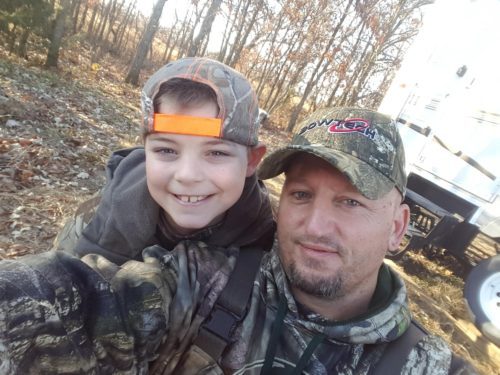
When that special day came for just the two of us to make that trip to the field, I felt confident that we had put in the time preparing for a successful hunt. I am testifying that there is nothing more rewarding than watching your child harvest his or her first game animal. The excitement in their eyes, and to feel the pride of knowing that you played a major part in their success, is a feeling like no other. Most importantly, there is a bond that develops between you and your child that makes it that much more special. A special closeness that could only come from time shared afield. A bond that, if properly nurtured, will last a lifetime.
Blog post originally shared on “The Break TV”.
By Bobby Raybourn
Bobby is a team hunter on “The Break TV” on the Pursuit Channel. He grew up near Odessa, MO and began hunting at a very young age alongside of his father and older brother. Bobby has also taken up Taxidermy in his spare time and his business is thriving.
Using Trail Cameras to Scout for Turkeys
March 26th, 2017 by BTC Editor
Knowing where to hang your trail cameras and what kind of settings to use when scouting for turkeys is important, as it can vary a little from using cameras for deer hunting. When hanging my trail cameras, whether I’m using them for deer or turkey hunting, I pretty much keep 3 things in mind when determining where to put them: bedding, food and travel routes. So, for deer I often like to hang my cameras where I know they will be coming from their bedding area to their feeding area, and vice versa. For turkeys, I like to do essentially the same thing: find where they are roosting and figure out where they are going when coming off the roost. These locations for deer are often different than they are for turkeys, so scouting is a must.
A few things to look for when you are scouting for good turkey trail camera locations are roosting sites, travel routes, strut zones, and feeding areas.
Roosting Sites
You will know a roosting site when you see one. I have found several on our property, and they have always been in tall, dead trees and have lots of turkey droppings underneath them. You may find some primary wing feathers as well. When hunting last year, I actually spotted a couple of toms still up on the roost, which further confirmed their roost site. I found another spot this spring while shed hunting – it was a dead tree in on the edge of our food plot – and found quite a bit of droppings and a wing feather underneath it.
Camera Setup:
If I know where a roosting site is, I personally like to set my trail camera where I expect they will be landing when they fly down from the roost. From observing turkeys while out hunting I have a good idea of where they usually land when they fly down. On my property, this is usually in one of our fields planted in wheat and clover.
Time-Lapse mode is a great option for fields this size so you don’t miss anything further out where turkeys may not trigger the camera. I have this Browning Strike Force trail camera set up quite a bit higher to have a better view of the field. As you can see in this photo, the turkeys are flying in off the roost.
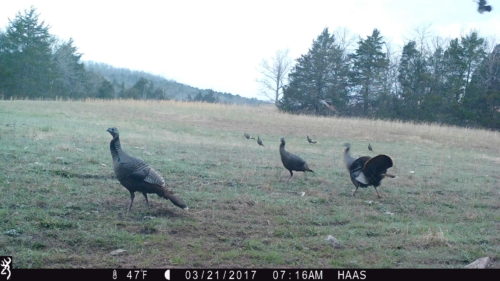
Travel Routes
I’ve noticed a couple of similarities in how both deer and turkey travel from my experiences hunting, and it seems they often prefer to take the easiest route possible. Some examples of routes I have seen both deer and turkeys using often is logging roads in the woods, creek crossings, openings in the timber, and holes in fences.
Camera Setup:
These are usually in small, tight spots so I prefer to hang my camera pretty low here and will often put my camera on burst mode so I don’t miss any action. I have this Browning Strike Force set to take 4 multi-shot images every 5 seconds.

Strut Zones
The best way to find these is to actually see a turkey using it in person. I know where a couple are on our property from observing the turkeys while out hunting. If you haven’t seen your turkeys using one, try looking for wing drag marks in the dirt while you’re scouting. On my property, our turkeys love to strut on the edge of one of our food plots where the sun hits them, so keep that in mind when looking for strut zone locations.
Camera Setup:
If you are looking to get some neat footage from your trail cameras, a Strut Zone is the perfect opportunity to switch your trail camera to Video Mode! Make sure you have a larger SD card in this instance as they can fill up pretty quickly on video mode.
This Browning Strike Force camera is actually in the same location as the “Roosting Site” listed above and Time-Lapse mode is what I prefer in this location due to the field size.
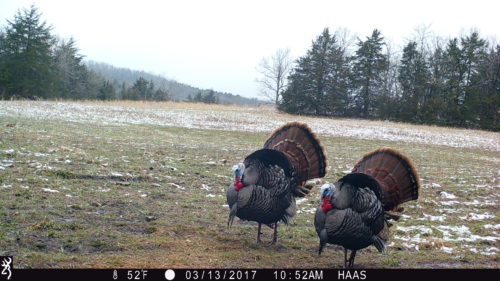
Feeding Areas
Food plots planted in chicory, wheat and/or clover are excellent options for hanging your trail cameras to scout for turkeys. We have one field planted in clover and chicory, and another planted in wheat and clover, both of which really seem to hold the turkeys on our property.
We also experimented one year by plowing up some of the ground on the edge of one of our food plots and the turkeys loved the easy access to insects there! You can see the plowed part in the photo below from the Browning Spec Ops:
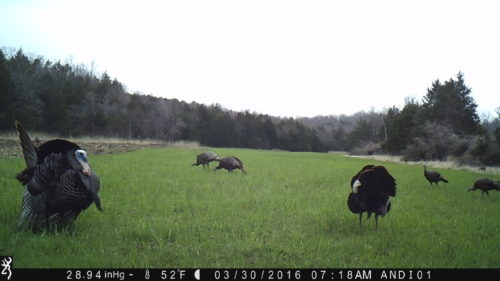
Camera Setup:
Once again, a good option in a field this size is Time Lapse mode so you can still catch turkey movement outside of the camera’s detection zone, and setting the camera a little higher up.
If you already have a pretty good idea of where the turkeys are feeding at, regular Trail Camera mode works just fine here as well, and I would probably up the picture delay to 20 or 30 seconds here so you aren’t filling up the SD card as quickly with tons of feeding pictures.
When making your game plan for opening day of Spring Turkey Season, keep in mind what you have learned from studying your trail camera pictures prior to season opener. Using trail cameras to scout for turkeys will give you a good idea on your flock size, how many different groups of turkeys you may have, and where you need to be setting up on opening day. You will be one step ahead of the turkeys and by using the right settings, will likely get some amazing trail camera pictures and/or videos along the way!
By Andrea Haas

Andrea Haas is a Pro-Staffer from Missouri who enjoys hunting deer, turkeys, and upland birds. She is also the founder of the Huntress View, an organization formed to help strengthen the ever growing community of women hunters.

